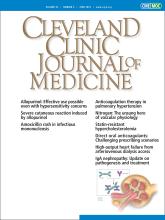Table of Contents
From the Editor
- Allopurinol hypersensitivity is rare, bad, and partially avoidable, but allopurinol can still be used effectively
The shadow of the 1984 Hande et al guidelines still hangs over clinical decision-making when managing allopurinol dosing in patients with gout and chronic kidney disease.
The Clinical Picture
- Severe cutaneous reaction induced by allopurinol
Three weeks after starting allopurinol for gout, an 86-year-old woman presented with a maculopapular rash and painful blistering and erosions of the oral mucosa.
- Amoxicillin rash in infectious mononucleosis
A 23-year-old woman developed a rash on the day she completed a 10-day course of amoxicillin for group A streptococcal infection.
1-Minute Consult
- Should I start anticoagulation in my patient newly diagnosed with pulmonary hypertension?
The decision hinges on the subtype of pulmonary hypertension the patient has.
Editorial
- Nitrogen: The unsung hero of vascular physiology
The seventh element on the periodic table—nitrogen—may not come to mind often in day-to-day medical practice, but it is more exciting than you might think.
1-Minute Consult
- My adult patient’s hypercholesterolemia is not responding to statins—what’s next?
Further investigation is needed when patients do not meet their target low-density lipoprotein cholesterol levels with statin therapy alone.
Review
- Direct oral anticoagulants: Challenging prescribing scenarios in everyday practice
Preapproval trials of direct oral anticoagulants excluded patients with extreme body weight and advanced kidney and liver disease and those who had undergone bariatric surgery. Cautious decision-making in these patients is warranted.
- High-output heart failure from arteriovenous dialysis access: A structured approach to diagnosis and management
Arteriovenous high-output heart failure is likely underdiagnosed because many clinicians are uncertain about when and how to evaluate for it.
- IgA nephropathy: Update on pathogenesis and treatment
Renin-angiotensin-aldosterone system inhibitors or corticosteroids remain the cornerstone of therapy, but new agents targeting the different “hits” in the pathogenesis of IgA nephropathy are being introduced.




